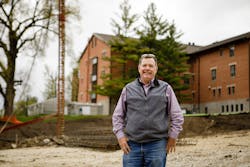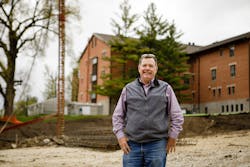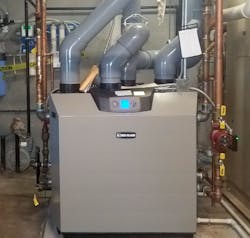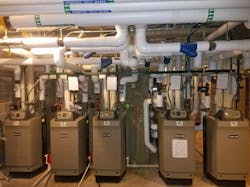College campus boiler change-out receives high marks for efficiency
MOUNT VERNON, IOWA — Inefficient, leaking boilers. Thousands of dollars in repairs. Sounds like a recipe for disaster for any end user, let alone an entire university campus. That was the case for Cornell College as the existing steam-heating system posed too many challenges to remain status quo.
Installed in the late 1800s, the original heating system consisted of a steam central plant that supplied all of the buildings on the university grounds with steam heat. Originally using coal, the school’s boiler plant was converted to gas in the 1960s. Three 350-horsepower gas-powered steam boilers handled heat for the entire campus. “When I joined the staff at Cornell College, 90 percent of the heat was produced by two steam boilers in our heating plant,” says Joel Miller, director of facility services for Cornell College.
“We were experiencing numerous faults with our in-ground steam lines and constant maintenance work on the steam boilers,” Miller says. “The steam lines were rusting, which required repairs from building to building. It would often take a week or longer to fix if one of the steam boilers went off line, and when one was finally up and running, then the other would go down.”
Replacing the steam piping was not an option. “It would have cost us significantly more money to replace all the steam piping and condensate piping throughout the campus,” Miller explains. “We wanted boilers that were user-friendly so we could train our team how to use them — plus a heating system that could be monitored and controlled remotely.”
Retrofitting campus buildings with high-efficiency condensing boilers provided the heating solution and peace of mind for Miller. Because of the age of the equipment, repairs were commonplace.
According to Miller, the old boilers and infrastructure from steam piping and condensate piping had deteriorated. “We have had several steam/condensing water leaks throughout campus,” he says. “It was costing us thousands of dollars for repairs. And the repairs always happened at the most inconvenient time — weather reaching -20° F figures or during a winter storm.”
Collaboration was key for the project as Miller and his team worked with Cedar Rapids, Iowa-based Pipe Pro and service manager Travis Godbey, who had been performing maintenance and repairs to the steam system for years.
Working with Pipe Pro’s Godbey, Miller and his team devised a strategy to take the college off the central steam plant and convert each building, one by one, to a standalone high-efficiency boiler system with remote operation. Pipe Pro completed eight conversions at the campus — all with Weil-McLain boilers. Installations occurred at Merner Hall, Olin Hall, West Science Center, Law Hall and other administration and academic buildings. The boilers are configured to control each building individually and connected through a web-based system for monitoring and control.
Each building upgrade featured its own unique set of challenges. Some buildings required additional piping and new pumps. The science building already had natural gas running to the building for lab experiments, but many of the other facilities only had steam pipe. “A major project hurdle was getting utilities to each building,” said Godbey. “We had to plan each upgrade in advance to make sure the utility company could get gas mains installed and then plan accordingly.”
The facilities team worked diligently with utility Alliant Energy on sustainability and efficiency measures. According to Miller: “With the addition of adding standalone boilers, we also added gas meters at each building. This was a necessity since we only had one or two main gas meters.”
One of the first retrofit projects took place at the popular residence facility, Olin Hall, situated across from the school’s sports complex. According to Miller, Olin is one of the farthest buildings from the steam plant and required constant repairs. “Residents were constantly losing heat and we were having many problems with the system,” Miller says.
The team installed five Weil-McLain Ultra 550 MBH high-efficiency condensing gas boilers in the building. The Ultra features boiler-to-boiler communication, Modbus and BACnet for linking with building automation systems, express set-up wizard, 10 preset typical heating systems, and updated controls interface for simpler navigation, at-a-glance boiler status, diagnostics and troubleshooting.
“The new boilers are 90 percent+ efficient, whereas the old boilers would be hard pressed to be 40 percent,” Miller says.
Three units were configured as the main heating boilers for Olin Hall while the other two were set up for domestic water. As part of the retrofit, thermostats were installed in each student’s room, so they could regulate temperature for optimal comfort.
As a standalone system, each building operates based on its own heating requirements. “One can set low or high limits and turn the boilers on as needed,” Miller says. “By setting parameters, building occupants have more heating options.”
In addition to Olin Hall, the West Science Center was selected for a boiler upgrade. The team sought to replace the existing heat exchanger with a boiler that would fit into the same space. The SlimFit model was chosen for this installation. Two SlimFit 750 series boilers were set up as natural gas and installed in the building’s mechanical room. “SlimFit boilers are manufactured for easy integration into existing systems,” Godbey says.
The boiler’s narrow housing enhances maneuverability for confined spaces and weight restricted areas. The design also increases usability and access for installing contractors, consulting engineers and facility managers for commercial retrofit projects. The West Science Building already had a steam-to-hot-water converter, so the team installed new T’s off of the header and then connected the boiler.
Miller says the buildings used the original pumps, original piping and plumbing for the retrofit, but the biggest issue was getting the intakes and exhaust for the boilers. “The SlimFit boiler was a perfect match for the space,” Godbey notes. “We were able to remove the heat exchanger, and then just made a few simple changes.”
Because the buildings were built in the late 1800s or early 1900s, mechanical rooms were smaller in size, and it proved difficult moving the old equipment out and the new equipment in. “For Merner Hall, another large residence, we had to install a 1.5 million Btu boiler,” Godbey says. “Thankfully, the SlimFit is built for tight spaces and we could bring it in through a standard door frame.”
Cornell College experienced several benefits from the elimination of the steam system and heat exchangers, and installation of the high-efficiency boilers. “The No. 1 concern was not having steam, especially if it happened to be a resident hall with 100+ students,” Miller says. “The risk of a freezing pipe burst, the possibility of trying to relocate 100+ students, etc., were daunting considerations.”
In addition, the boilers are connected to a campus-wide, web-based building control system for easy monitoring. “I can easily track every unit on campus and can even set alarms if needed,” Miller says. “The control system displays boiler parameters from each building on any computer, note pad or phone and our team can make adjustments as needed in real time. This was never a possibility with the old system.”
Overall, the campus has experienced a 15 percent reduction in gas usage after eight conversions. But most important, Miller reported that students and teachers are pleased with the climate of the classrooms and residences.



